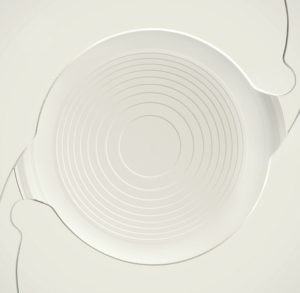
The Tecnis Symfony lens is an intraocular lens that is implanted during cataract surgery after the cataract has been removed. In contrast to a standard monofocal lens, the Tecnis Symfony lens has the ability to treat presbyopia, a condition that prevents patients from seeing both far and near in focus at the same time.
This lens was FDA approved in 2016 and is unique in that it is not considered a multifocal lens, such as the ReSTOR multifocal or the Tecnis multifocal. A multifocal lens gives patients two distinct distances where images are in focus, such as far and near. In between the far and near focal points, the images are not as clear. With the Tecnis Symfony lens, the images are in focus at far and near, but also everywhere in between. It provides a range of distances within which everything is in focus.
The Tecnis Symfony lens achieves this increased range of vision by using a new set of proprietary rings on the surface of the Tecnis lens platform, the same platform used in their other lenses, such as the Tecnis multifocal, the Tecnis toric, and the standard Tecnis monofocal lens.
Just as with multifocal lenses, there is an increased risk for halos and glare around lights at night. However, there is also an increased risk of seeing starburst around lights sources as well. These may be worse if pupil sizes are large at night. Overall, these side effects are well-tolerated and decrease with time.
A significant advantage of the Tecnis Symfony lens is that it is more forgiving with ocular pathology compared to a multifocal lens. If a patient has dry eyes or mild macular degeneration, a multifocal lens would potentially lead to worse vision, whereas the Tecnis Symfony lens is more likely to perform equally as well as a standard mono-focal lens.
The Tecnis Symfony lens also has a versions that can correct astigmatism as well, called the Tecnis Symfony Toric lens.
When you come in for your cataract consultation, we can discuss whether the Tecnis Symfony lens is best suited for your individual needs.